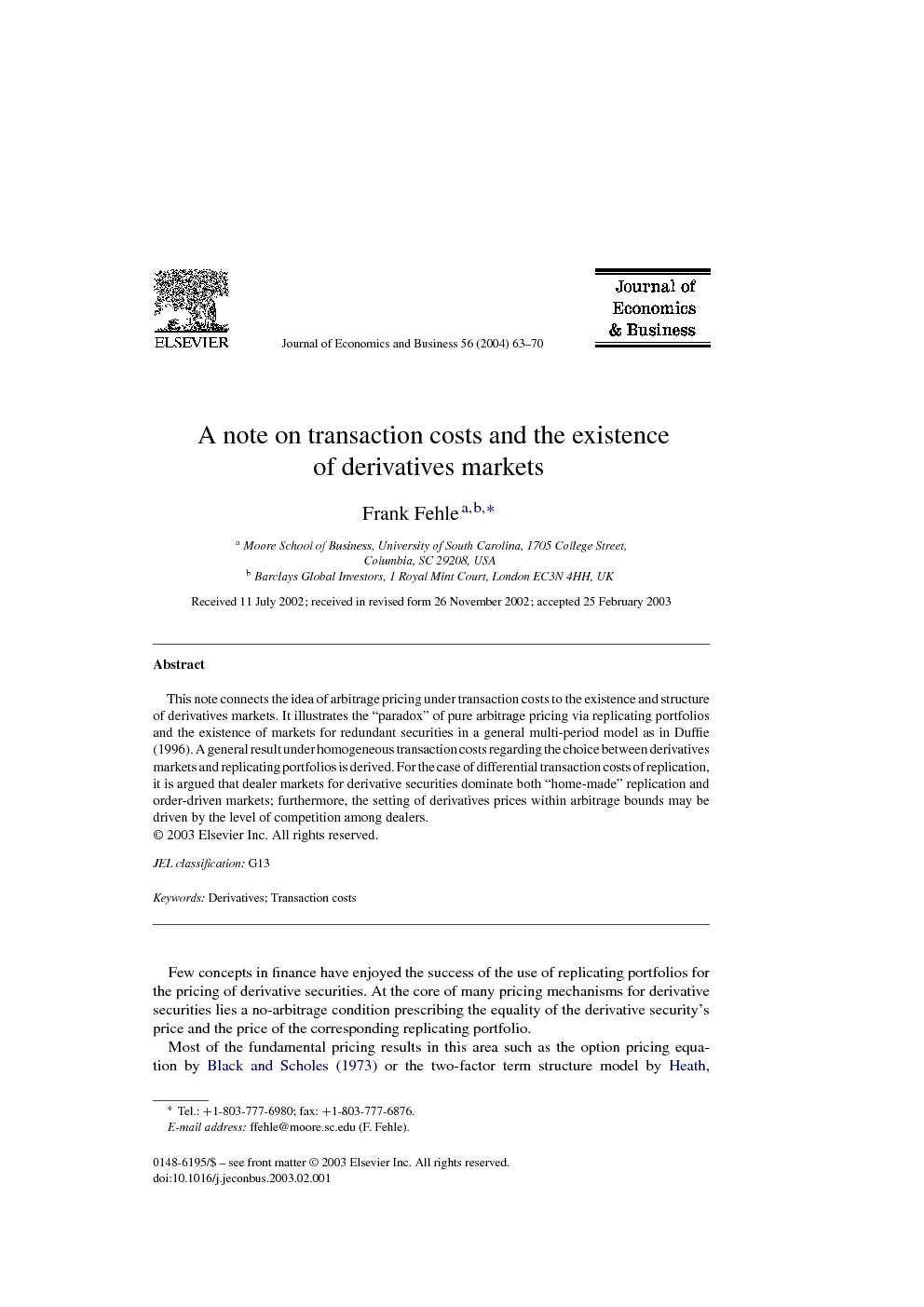This note connects the idea of arbitrage pricing under transaction costs to the existence and structure of derivatives markets. It illustrates the “paradox” of pure arbitrage pricing via replicating portfolios and the existence of markets for redundant securities in a general multi-period model as in Duffie (1996). A general result under homogeneous transaction costs regarding the choice between derivatives markets and replicating portfolios is derived. For the case of differential transaction costs of replication, it is argued that dealer markets for derivative securities dominate both “home-made” replication and order-driven markets; furthermore, the setting of derivatives prices within arbitrage bounds may be driven by the level of competition among dealers.
Few concepts in finance have enjoyed the success of the use of replicating portfolios for the pricing of derivative securities. At the core of many pricing mechanisms for derivative securities lies a no-arbitrage condition prescribing the equality of the derivative security’s price and the price of the corresponding replicating portfolio.
Most of the fundamental pricing results in this area such as the option pricing equation by Black and Scholes (1973) or the two-factor term structure model by Heath, Jarrow, and Morton (1990) ignore the existence of imperfections such as portfolio constraints and transactions costs. This omission is interesting in light of the fact that without imperfections markets for derivative securities should not exist or at least their existence should be a matter of indifference: investors wishing to obtain the payoff pattern from the derivative security could simply buy the corresponding replicating portfolio at the same cost. Yet derivative markets do exist and their explosive growth over the past 20 years is testament to the success of derivative securities as financial innovations.
This “paradox” can be interpreted as a violation of the second fundamental theorem of asset pricing, as introduced by Harrison and Kreps (1979), and Harrison and Pliska (1981), which shows that the uniqueness of the equivalent martingale measure is a necessary and sufficient condition for market completeness. In incomplete markets, the existing securities do not span a complete payoff space. Derivative securities are not truly “derivative” or redundant in the sense that they provide previously unobtainable payoffs. Examples of the incomplete markets literature are Adler and Detemple (1988), Cvitanić and Karatzas (1992), Duffie and Zariphopoulou (1993), He and Pages (1993), Jouini and Kallal (1995a), Scheinkman and Weiss (1986), and Svensson and Werner (1993). With incomplete markets replicating portfolios may not exist even though approximating portfolios may exist and the “paradox” vanishes.
One potential source of market incompleteness are frictions such as transactions costs and portfolio constraints. Beginning with Leland (1985) this literature extends the theory of derivatives pricing to consider the effects of such frictions. In an economy with transactions costs, the payoffs of derivative securities can (potentially) be replicated but the securities may still exist, if replication is costlier than the derivative security itself. In this case arbitrage bounds can be derived which depend on the structure of the transactions costs among other things. Allowing for heterogeneous consumers and heterogeneous transaction costs the equilibrium price of a derivative security must lie inside the arbitrage bounds but may not lie at the no-arbitrage price without transactions costs. Other work in this area is Boyle and Vorst (1992), Bergman (1995), Cvitanić and Karatzas (1993), Davis, Panas, and Zariphopoulou (1993), Edirisinghe, Naik, and Uppal (1993), Grannan and Swindle (1996), Korn (1995), and Whalley and Wilmott (1997).
The focus of this note is on the interaction of transaction costs and derivatives market existence, and its implications for the market design and for the provision of liquidity services of derivative securities. To simplify the analysis transaction costs are explicitly modeled for redundant securities or their replicating portfolios only, thereby avoiding problems of existence and equilibrium pricing. The thrust of the analysis is directed at agents’ choices between holding derivatives and their replicating portfolios, an area mostly neglected by previous research. Using the concept of arbitrage bounds, it is then argued that market structure, such as the level of competition in a derivatives markets, may have implications for observed derivatives prices.
The remainder of the note is structured as follows: Section 1 introduces the model of the economy without transaction costs, while Section 2 provides the main results regarding the existence of derivatives markets with transaction costs. Section 3 concludes. Proofs and derivations are contained in Appendix A.
This note connects the idea of arbitrage pricing under transaction costs to the existence and structure of derivatives markets. While the effect of transaction costs on derivatives pricing has been studied previously in papers such as Delbaen and Schachermayer (1994), Cvitanić, Pham, and Touzi (1999), and Constantinides and Zariphopoulou (1999), the connection among transaction costs and derivatives market structure is generally not addressed in this line of research. The note first illustrates the “paradox” of pure arbitrage pricing via replicating portfolios and the existence of markets for redundant securities in a general multi-period model. It then derives a general result under homogeneous transaction costs regarding the choice between derivatives markets and replicating portfolios. Finally, for the case of differential transaction costs of replication, it is argued that dealer markets for derivative securities dominate both “home-made” replication and order-driven markets as dealers with transaction cost advantages can provide other agents desiring a derivative position. In the case of differential transaction costs the setting of derivatives prices within arbitrage bounds may be driven by the level of competition among dealers.


